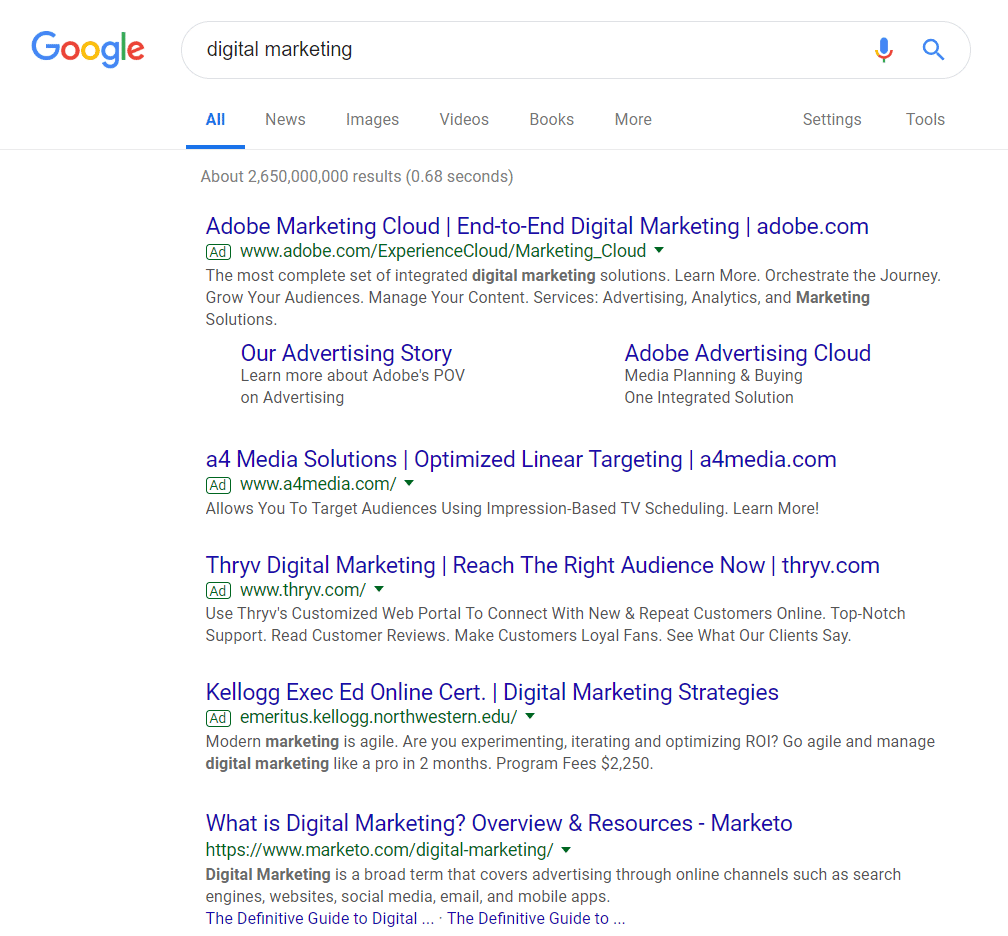Pay-per-Click and Google Adwords
When 98% of users who use a search engine choose sites listed on the first page, ranking in the top few results in Google or other popular search engines means more traffic to your site.
Depending on your business, it can be hard to make it into the top search results on Google organically. But there are ways to get your business and website at the top where more people can see you.
Google ads and pay-per-click are powerful methods to rank higher and gain more visitors to your website. If you’ve been wondering how to get started or what it’s all about, read on for important information about these advertising options.
Pay-per-click (PPC) refers to a form of online advertising where you only pay for the ad after someone has clicked it.
Google Ads uses PPC to auction ad space at the top and bottom of the search engine result page (SERP).

Paid ads have a green “Ad” symbol to the left of the displayed URL, while organic search results do not. Organic search results are pages that rank high on the SERP based on relevance and authority, but how does Google determine which ads are shown?
Here are three key aspects of Google Ads that you should know:
Google Auctions Keywords
When someone makes a query, keywords will trigger relevant ads. Depending on how popular a keyword is, you might have to bid more to compete with other companies. You have a good chance of being placed in the top spot if you have the highest bid (the highest bid does not guarantee you the top spot, but we’ll get to that later).
Because these ads are PPC, you will pay that bid every time someone clicks on the ad. You can set your account to automated or manual bidding.
Automated bidding helps you reach a certain goal by adjusting your bid. For example, enhanced cost-per-click (CPC) would automatically adjust your bid to increase conversions without upping the cost-per-conversion.
Manual bidding allows you to set a maximum CPC and adjust your bids per keyword, which means you can prioritize keywords you find more valuable and relevant to your ad.
Google’s TrafficEstimatorService can help you determine how much you should be bidding for keywords based on how much traffic that keyword creates.
The Auction Considers More than Just Highest Bid
Although bidding is important to your rank, Google considers several other aspects of an ad to determine the quality; the higher the quality, the more likely it is to be shown.
To be displayed at the top of the SERP, your ad must meet a certain rank threshold. Expected clickthrough rate, ad relevance, and landing page experience are a few indicators that can affect rank.
In the end, your actual CPC is calculated based on ranking, competition from other advertisers, and meeting the thresholds.
Google Display Network
GDN shows ads on sites with relevant content. These ads can be still images, animated, or interactive. Although not as popular as the text SERP ads, this format is great for brands who want more than text-based advertising.
Like text ads, you can automatically or manually manage your ads.
Automatic placement means Google chooses which sites to show your ad on based on how relevant that site is to your business.
Manual placement means you choose which sites you are advertised on. The placement of your ad can be critical, and you should also think about where you don’t want your ad displayed.
Unlike SERP text ads, GDN connects you with a customer before a search is even made, putting you at the very start of the buyer’s journey. This means that even if the viewer doesn’t click the ad, your brand is still getting promoted, and because these ads are also PPC, you’re getting promoted for free.
Digital advertising might sound intimidating, but Google Ads makes it easy to promote your brand to the right people at the perfect time and place.
To learn more about digital advertising, check out our Intro to Digital Advertising!
Thanks for reading,
Christine







